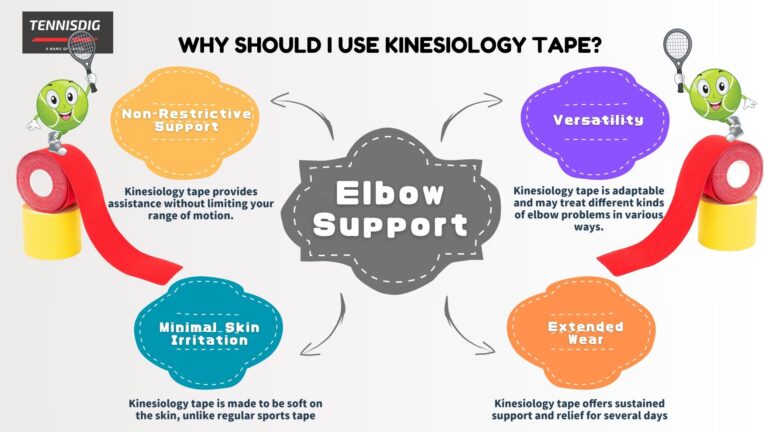Whether the result of an injury, overuse, or conditions like tennis elbow, elbow pain can significantly negatively influence everyday activities and sports performance.Kinesiology tape has become a well-liked and useful tool for offering assistance, reducing pain, and speeding up the healing process for various musculoskeletal conditions. In this thorough guide, we’ll go over how to correctly apply kinesiology tape to an elbow, examine how well it works for elbow discomfort, and discuss the advantages of using this adaptable tool as part of your self-care regimen.
How is an elbow taped?
When taping an elbow, kinesiology tape must be used with accuracy and attention to detail. To guarantee appropriate and successful application, adhere to the following steps:
Step 1: Wash your skin
To guarantee the best adherence, start with dry, clean skin. Ensure the application area is free of oils, lotions, or dirt.
Step 2: Measure the Strips in Step Two
You will need two “Y” strips of kinesiology tape for elbow taping. To measure the first strip, measure the distance between your wrist’s inner and mid-forearm.Cut the strip into two tails once it reaches this length by cutting from the middle to the ends.
Measure down the back of the arm, in the direction of the inside of the forearm, and from the outside of the elbow for the second “Y” strip.
Step 3: Apply the First “Y” Strip in Step Three:
With the tails extending up your forearm, position the base of the “Y” strip close to the inside of your wrist. Adhere the tape in a moderately stretched-out manner along the inside of the forearm, ending slightly below the elbow.
Step 4: Apply the Second “Y” Strip in Step Four:
Put the second “Y” strip on now. After positioning the base around the outside of the elbow, mirroring the initial strip’s course, gently guide the tails around the back of the arm and towards the inside of the forearm.
Step 5: Extra Assistance (Optional)
You can use extra kinesiology tape strips if you need more support or to focus on a particular location. You can apply them to the triceps or biceps, depending on your demands.
Step 6: Massage and Stimulate
To ensure maximum adherence to the skin, lightly rub the tape after application to activate the adhesive. This step is essential to ensure the tape stays in place throughout movement.
Does elbow discomfort respond well to kinesiology tape?
Kinesiology tape has become increasingly well-liked because it may offer support without limiting mobility. Correct use can provide multiple advantages for elbow pain:
1. Improved Blood Circulation:
The tape’s mild pressure and skin-lifting action may contribute to better blood circulation, which may lessen inflammation and hasten healing.
2. Pain Relief:
By supporting the harmed muscles and joints, kinesiology tape may help reduce pain. Additionally, it helps ease discomfort by releasing pressure from the nerves.
3. Enhanced Flexibility:
Kinesiology tape resembles skin flexibility, unlike conventional athletic tape, which limits movement. This preserves the afflicted area’s support while enabling a complete range of motion.
4. Lessened edema:
By separating the skin from the underlying tissues, the lifting action of kinesiology tape can assist in lessening edema. This may be especially helpful for ailments when there is an accumulation of fluid surrounding the joint.
For my elbow, why should I use kinesiology tape?

1. Non-Restrictive Support:
Kinesiology tape provides assistance without limiting your range of motion. This makes it the perfect choice for people who still wish to lead an active lifestyle but are experiencing elbow pain.
2. Versatility:
Kinesiology tape is adaptable and may treat different kinds of elbow problems in various ways. Customized tape can target specific locations for tennis elbow, golfer’s elbow, or general discomfort.
3. Minimal Skin Irritation:
Kinesiology tape is made to be soft on the skin, unlike regular sports tape, which can irritate or hurt the skin when removed. Because of its hypoallergenic adhesive, those with sensitive skin can use it.
4. Extended Wear:
Kinesiology tape offers sustained support and relief for several days and is made to stay in place during movement. This longer wearability makes it useful for people with persistent elbow problems.
The strips’ measurements for elbow support
First “Y” Strip for Taping the Elbow:
When the kinesiology tape reaches the desired length, cut it in half lengthwise, beginning in the middle and working your way out.
Second “Y” Strip for Taping the Elbow:
Measure in the direction of the inside of the forearm, around the back of the arm, and from the outside of the elbow. Once the kinesiology tape reaches this length, cut it in half, creating two tails. This strip will be applied along the outside of the forearm.
Last Words
One useful tool for treating and controlling elbow pain is kinesiology tape. It improves blood circulation, relieves pain, and offers non-restrictive support when used properly. Kinesiology tape, appropriate rest, and any required medical procedures can all help you lead a more comfortable and active life when included in your self-care regimen.
Consult a healthcare provider for an accurate diagnosis and advice on using kinesiology tape for your ailment, as you should with any self-treatment method. Kinesiology tape can be a helpful ally on your path to better elbow health, whether you’re an athlete looking to sustain peak performance or a layperson seeking relief from persistent elbow discomfort.

